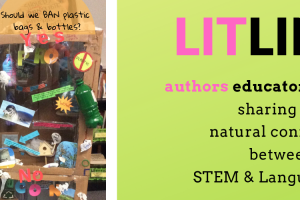GUEST BLOGGER DANNA SMITH
Students will learn how to compose haiku through tutorials that are divided into two levels: Level 1—three simple lines for beginners and Level 2—syllable counting for advanced students. Then, they will write haiku and explore creative applications through templates and artistic activities.
What is haiku?
Haiku (hi-koo), means “light verse.” It is a spin-off of a poetry form called Hokku and is one of the oldest forms of poetry in the world. At its center, haiku are unrhymed three-line poems that focus on nature and are written in simple language.
Level 1— Simplified haiku
At this level, students concentrate on the “where,” “what,” and “when” of the haiku moment without a specific syllable count, as in this example:
Where it happens: on grandma’s porch
What is happening: beetle on its back
When it happens: stormy morning
Step 1
Ask students to look outside and select an object from nature.
Example: butterfly
Step 2
Have students list descriptive phrases that tell WHERE the haiku moment is happening. Examples:
- on a green leaf
- in the park
- on my brother’s hand
- among wildflowers
- on a pink rose petal
Step 3
Ask students to create a list of descriptive phrases describing WHAT is happening. Examples:
- hungry butterfly sips nectar
- tiny butterfly feet tickle
- butterfly flaps colorful wings
- butterfly makes a friend
- butterflies dance
Step 4
Now, students brainstorm a list of phrases that tell WHEN the haiku moment is happening. Examples:
- at dawn
- one summer day
- at lunchtime
- one hot afternoon
- all day long
Step 5
Have students choose one “where,” “what” and “when” phrase from each list and write their haiku in three lines.
(where) among wildflowers (6)
(what) butterflies dance (4)
(when) at dawn (2)
Students have now written their first haiku! If they’d like, they can swap the “where” and “what” lines:
(what) butterflies dance (4)
(where) among wildflowers (6)
(when) at dawn (2)
Level 2— Traditional haiku
At this level, students will be guided through five interactive steps to create a traditional 17-syllable haiku.
Step 1
Ask your students to select an object from nature.
dandelion
Step 2
Tell your students to use as many of the five senses as possible to create a list of words and phrases describing the object. What does it look like? Touch it—what does it feel like? How does it smell? Does it make a sound? How does the object make them feel? What might the object be feeling? Examples below:
- summertime
- springtime
- bees love them
- they love bees
- soft petals
- short green stem
- fluffy seed ball
- hollow stem
- bumble bees love them
- blowing on them is fun
- not fragrant
- blowing white fluff
- feels soft
- looks happy
- looks like polka dots on the lawn
- covering the lawn
- going to seed
- how many wishes in one blow?
- making a wish hopeful
- they close at night
Step 4
Have your students write a haiku with ideas from their list. They should not worry about the syllable count for now.
fluffy seed ball (4)
ready, set, blow (4)
dandelion summer (6)
Step 5
Remind students how to count syllables. Rewrite and adjust the wording to create a 17-syllable haiku with 5 syllables in the first line, 7 in the second line, and 5 in the third line. Notice the changes that were made to the haiku above to create the correct syllable count for the revised haiku below:
white fluffy seed ball, (5)
wishes blowing in the wind—(7)
dandelion spring (5)
Creative haiku activities
Encourage students to celebrate haiku by performing the activities below with the provided downloadable templates:
Kuhi
Carving a poem on a stone is an old Asian tradition. These stones, called kuhi (coo-hee), decorate gardens, parks, and temples worldwide. Download the template for students to create a poem stone on paper or paint natural rocks!


Haiku comics
Comic strips offer a fun way to celebrate haiku. Download the provided comic strip template then ask your students to create a comic. Examples are below. Encourage students to use speech bubbles, thought bubbles, and sound words, like swish, pop, or splash.
Featured image credit: “First Haiku with the New Set” by glindsay65 is licensed under CC BY-ND 2.0.
Danna Smith is a poet and award-winning author known for her delightful and informative books. She has written over twenty-five books for children, including The Hawk of the Castle (Candlewick), which was a 2018 Bank Street College of Education Best Children’s Books of the Year, and Peek-A-Boo Haiku (Little Simon), a School Library Journal starred review, and is on the American Library Services to Children: Notable Children’s Book list 2024. Her works range from board books and Little Golden Books for the youngest readers, to fiction and nonfiction picture books for older readers. She also writes for adults and young adults. You can learn more about Danna and her books on her website and pop over to her poetry blog. Find Danna on social media, too: Instagram LinkedIn Tumblr LinkTree












1 Comment
Leave your reply.